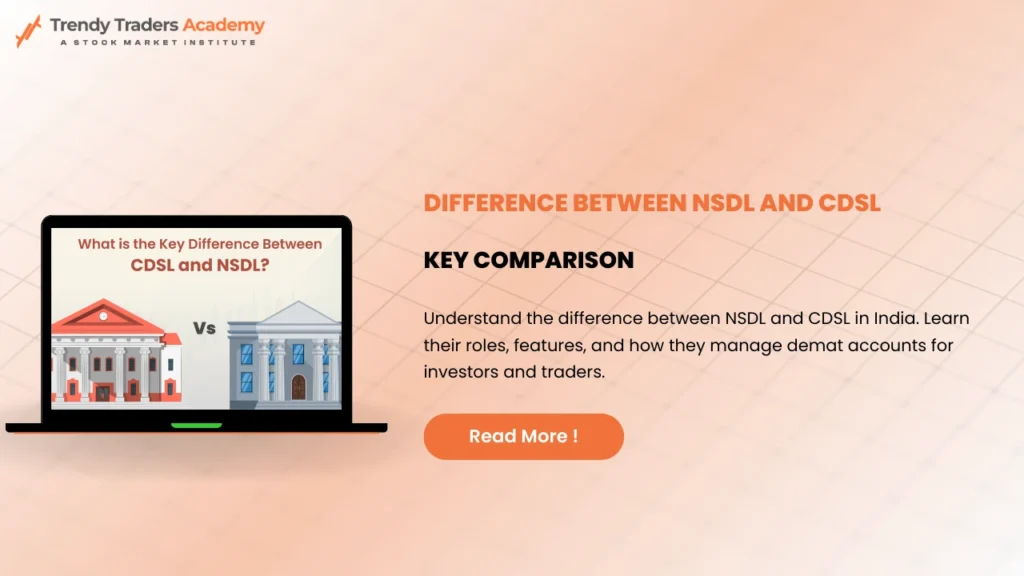
Difference Between NSDL and CDSL: A Fresh Explanation for Investors in 2025
Imagine you own valuable items that used to be kept locked in physical cabinets. What if someone told you that now, instead of bulky drawers, those items are stored in futuristic, secure digital vaults? This idea explains the transition from paper shares to dematerialized accounts managed by NSDL and CDSL.
For a proper understanding, this guide dives into what is NSDL and CDSL, explains the full forms of NSDL and CDSL, and dives into their distinct but complementary roles. If one has ever wondered about the difference between NSDL and CDSL,they should get ready for a fresh, relatable explanation that they won’t find in normal textbooks.
Digital Vaults in the Stock Market: NSDL and CDSL Full form Unmasked
One should consider NSDL and CDSL as major leading digital vault operators in the financial city of India.
- NSDL (National Securities Depository Limited) was the trailblazer who, in 1996, found a new way to safely store shares electronically.
- CDSL (Central Depository Services Limited) followed, offering another set of secured vaults from the year 1999 onwards.
Both vaults function by providing seamless storage, transfer, and management of securities without the dangers and inefficiencies associated with paper based certificates .
Why Switch From Paper Drawers to Digital Vaults?
Before NSDL and CDSL, investors struggled with paper certificates: lost documents, fake papers, slow ownership transfers, and tedious processes to claim dividends.
These digital vaults offer:
- Enhanced security preventing physical loss.
- Instantaneous transferability in trades, unlike slow postal deliveries.
- Easier monitoring with online access anytime from anywhere.
- Automating benefits like dividends without extra effort.
The switch created efficiency and trust, revolutionizing Indian markets.
Now Let’s Get to the Heart — How NSDL and CDSL Differ
They are not competitors but cousins functioning in a similar ecosystem, with differences reflecting their origins and focus:
- Age and Roots:
- NSDL: The elder sibling, born in 1996, backed heavily by NSE and government efforts.
- CDSL: The younger sibling, formed in 1999, sponsored largely by BSE and private financial bodies.
- Market Reach:
- NSDL manages around 60% of India’s demat accounts, with a strong grip on metro and institutional trade.
- CDSL holds the remaining 40%, growing fast especially among retail users and smaller cities.
- Technology and Accessibility:
- NSDL boasts a mature, battle-tested platform favored by larger brokers.
- CDSL focuses on user-friendly interfaces aimed at new-age investors and mobile users.
- Broker and Exchange Tie-ups:
- NSDL frequently collaborates with brokers connected to NSE.
- CDSL generally aligns with brokers working with BSE.
Picture This: Choosing Your Locker Based on Your Broker
Suppose you want to keep your jewelry safe. The bank (broker) you trust chooses where your locker goes—either Vault NSDL or Vault CDSL. The lockers both meet safety standards, but the bank’s preference decides your locker location. So, your investment experience depends more on your bank’s service than the locker’s brand.
Key Benefits Shared by Both Digital Vaults
- No Paper, No Worries: Removes problems linked to physical certificates.
- Speedy Transactions: Shares move fast; delays become a thing of the past.
- Convenient Perks: Dividend credits, bonus shares, rights issues happen seamlessly.
- Easy Monitoring: Use apps or portals to stay updated on your holdings.
- Pledge Without Paper: Borrow against your shares easily, securely.
Opening Your Demat Account: Step-by-Step
- Choose a trusted broker or bank (your Depository Participant).
- Complete KYC with ID, address proof, and photo.
- Fill an account opening form specifying your DP (linked to NSDL or CDSL).
- Pass verification and receive your account credentials.
- Manage and trade securities electronically anytime, anywhere.
How NSDL and CDSL Ensure the Security and Convenience of Your Investments
Aspect | NSDL | CDSL | Benefit to Investor |
Regulatory Oversight | Monitored by SEBI with stringent compliance | Complies strictly with SEBI regulations | Ensures your assets are safeguarded under a strong legal framework |
Custodial Role | Holds securities on behalf of investors only | Acts as a secure custodian without ownership rights | Protects investor ownership by separating asset custody from ownership |
Transaction Processing | Electronic transfer reduces manual errors | Electronic system ensures swift and accurate settlement | Faster transaction settlements with minimized errors and fraud risk |
Access to Holdings | Provides real-time online access via DP portals | Offers user-friendly mobile apps and web interfaces | Convenient, anytime access to portfolio and transaction history |
Corporate Actions Handling | Automates dividends, bonuses, splits | Seamless crediting of investor entitlements | Investors receive benefits directly and timely, no paperwork needed |
Security Features | Employs multi-level encryption and secure protocols | Implements continuous monitoring and strict data safety standards | High level of security protects against cyber threats and unauthorized access |
Support for Pledging | Enables electronic pledge of securities for loans | Facilitates simple, fast pledging and lien marking | Investors can leverage assets for loans without paperwork delays |
What to Keep in Mind When Picking Your Depository Participant (DP)
Consideration | Why It Matters |
Ease of Access | Look for smooth online and mobile experience |
Fee Structure | Transparency on charges keeps costs in check |
Customer Support | Reliable help is crucial when you face issues |
Extra Tools | Research, alerts, portfolio tracking can aid investing |
DP’s Reputation | Trustworthy DPs ensure secure handling of your assets |
The Road Ahead: NSDL and CDSL in the Future
Expect:
- More retail-friendly mobile apps and digital services.
- Experimentation with blockchain to strengthen transparency.
- Services beyond equity shares: bonds, mutual funds, IPOs.
- Increased presence across small towns, enabling broader financial participation.
Summary Table for difference between nsdl and cdsl
Parameter | NSDL | CDSL |
Launch Year | 1996 | 1999 |
Market Share | Around 60% | Around 40% |
Promoted By | NSE and Government | BSE and Financial Institutions |
Target Investor Base | Institutions and urban investors | Retail investors, tier 2/3 cities |
Broker Associations | Closely tied with NSE | Closely tied with BSE |
Technology Focus | Mature, scalable, enterprise-driven | User-centric, mobile-friendly |
Conclusion
NSDL and CDSL differences majorly stems from their origins, partnerships between both of them, and market focus. Both function in a vital and equal role towards digitizing the market of India’s securities. Whether one’s holding are with NSDL or CDSL, the investments remain safe, secured and accessible for an individual.
Getting a grasp on what is NSDL and CDSL, their full forms, and how they function aids in empowering a individual investor. Instead of fretting about the depository, one must focus on selecting a DP that provides them good service, reasonable fees and simple accessibility.
One must remember that digital locker is just a one portion of a smooth and transparent investment process that keeps trading efficient and hassle-free.
FAQ'S
What is NSDL and CDSL ?
NSDL (National Securities Depository Limited) and CDSL (Central Depository Services Limited) are two depositories in India that hold securities like stocks, bonds, and mutual funds in electronic form for investors.
What is the nsdl and cdsl full form ?
NSDL: National Securities Depository Limited
CDSL: Central Depository Services Limited
Who are the promoters of NSDL and CDSL ?
- NSDL is promoted by the National Stock Exchange (NSE) and major financial institutions like IDBI Bank.
- CDSL is sponsored by the Bombay Stock Exchange (BSE) and HDFC Bank, State Bank of India, and Canara Bank.
What is the difference between NSDL and CDSL ?
Both NSDL and CDSL offer the same services with minor differences. Choosing one depends on your Demat account provider (Depository Participant). NSDL is widely used by institutional investors, whereas CDSL is more popular among retail investors.
Can I have accounts with both NSDL and CDSL?
- Yes. Many investors hold multiple demat accounts.
Are costs different between NSDL and CDSL?
Mostly depend on your broker or DP; both depositories have comparable fee ranges.
Is one safer than the other?
Both strictly regulated and secure, offering equal protection.
How do I know which depository holds my shares?
Your DP will inform you, and your account statements mention it clearly.
What is NSDL and CDSL full form?
NSDL stands for National Securities Depository Limited and CDSL stands for Central Depository Services Limited.











